– This page orginally created in 2001 by Betsy Klinger and Diana Talbert.

FLORA IN THE GROVE
– This page orginally created in 2001 by Betsy Klinger and Diana Talbert.
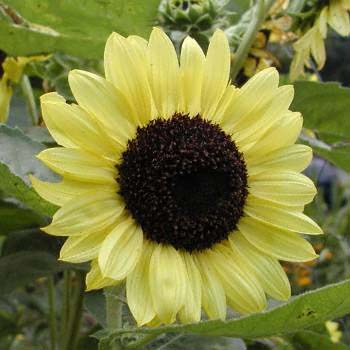
August 11SUNFLOWER - Helianthus were considered by the Incan Indians of Peru to be a symbol of the sun and worshipped it accordingly.
American pioneer families found many uses for sunflowers. New growth has been eaten like asparagus. The seeds are eaten as a tasty snack, used in baking, and are a favorite of birds. Oil from the seeds was used in cooking and for making soap, and the blossoms made a good yellow dye. The leaves and stalks were used as fodder, and the fibers from the stalks were used to make cloth. (One present-day Grover has fashioned a didgeridoo from the stalk of a giant sunflower!) Sunflowers were also planted close to the house because of the superstition that sunflowers were protection against malaria.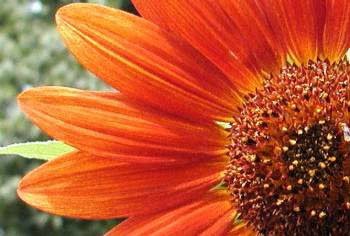
Many varieties are now available, with a wide range of color, height, and flower size, and their uses aremainly ornamental. Also entertaining, if you watch birds and squirrels as they feed.
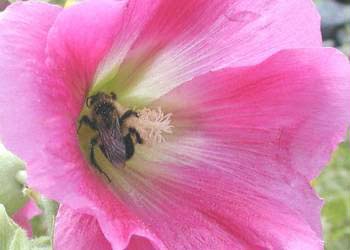
August 11HOLLYHOCKS - Althea (from the Greek meaning "that which heals") was grown in ancient China both as an ornamental plant and as food. Peasants ate the leaves, cooked like other spring greens, and the flower buds were considered quite a delicacy.
The Romans used hollyhock as a potherb and as an insect repellent. Leaves and flowers strewn on the floors helped repel lice, fleas, and other insect pests. Various parts of the plant were used in the forms of juice, poultices or tea, which soothed the digestive tract and relieved sores in the mouth or an inflamed throat.
Often used in cottage gardens, hollyhocks were planted beside beehives, for the bees made a wonderful honey from the blossoms. Hollyhocks were brought to North America in 1631, where they are still popular, primarily for their tall beauty in the mixed garden.
 August 11 PASSIONFLOWER VINE is also known as Maypop, an intriguing name of unknown derivation. The lovely and intricately detailed Passifloraincarnata attracts large bumblebees, which are most drawn to the pinkish hairs nearest the center of the flower. In getting there, the bee brushes his furry back beneath the hinged yellow anthers and picks up pollen. At another blossom, the pollen comes in contact with the light greenish stigmas, fertilizing that bloom. The edible fruit, called granadilla or water lemon, will be about 3 inches long, and the yellowish pulp is said to be succulent and sweet. Passionflower has long been used as a calmative agent and sedative. Early American Indians applied the crushed leaves as a poultice to treat bruises and other injuries; they also brewed the woody vines and drank the tea to soothe nerves. In small doses, passionflower has no known toxicity. Used as an herbal bath, passionflower doesn't excite, as its name might suggest, but rather it soothes the body.
August 11 PASSIONFLOWER VINE is also known as Maypop, an intriguing name of unknown derivation. The lovely and intricately detailed Passifloraincarnata attracts large bumblebees, which are most drawn to the pinkish hairs nearest the center of the flower. In getting there, the bee brushes his furry back beneath the hinged yellow anthers and picks up pollen. At another blossom, the pollen comes in contact with the light greenish stigmas, fertilizing that bloom. The edible fruit, called granadilla or water lemon, will be about 3 inches long, and the yellowish pulp is said to be succulent and sweet. Passionflower has long been used as a calmative agent and sedative. Early American Indians applied the crushed leaves as a poultice to treat bruises and other injuries; they also brewed the woody vines and drank the tea to soothe nerves. In small doses, passionflower has no known toxicity. Used as an herbal bath, passionflower doesn't excite, as its name might suggest, but rather it soothes the body.
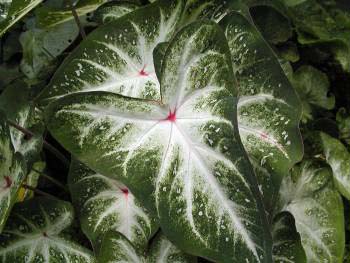 August 11CALADIUM - These unusually marked foliage plants are from bulbs and are easy to grow, their main requirements being moisture and warmth. Bulbs can be dug and overwintered in a cool but not freezing spot and replanted in the spring. The flowers are actually quite small and can be found crowded onto a club like spike. Depending on their leaf patterns, Caladiums can add drama OR calm to a shady spot or shallow pond.
August 11CALADIUM - These unusually marked foliage plants are from bulbs and are easy to grow, their main requirements being moisture and warmth. Bulbs can be dug and overwintered in a cool but not freezing spot and replanted in the spring. The flowers are actually quite small and can be found crowded onto a club like spike. Depending on their leaf patterns, Caladiums can add drama OR calm to a shady spot or shallow pond.
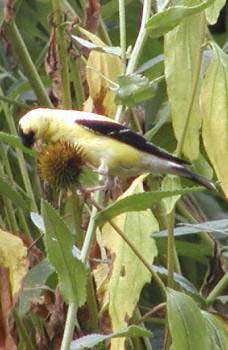 August 11GOLDFINCH ON PURPLE CONEFLOWER - Bright blooming flowers are lovely, but after the colors fade they still aren't finished... the prickly seed heads of Echinacea purpura (Echinacea fromthe Greek for 'hedgehog') make a dandy meal for a Common Goldfinch.
August 11GOLDFINCH ON PURPLE CONEFLOWER - Bright blooming flowers are lovely, but after the colors fade they still aren't finished... the prickly seed heads of Echinacea purpura (Echinacea fromthe Greek for 'hedgehog') make a dandy meal for a Common Goldfinch.
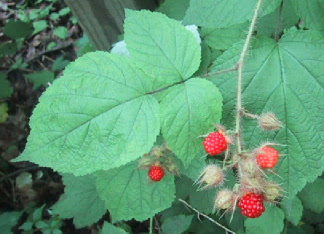 July 8GROVE WINEBERRIES - What connection is there between these red raspberries, Caryline Kelly's great-great grandfather, and Maple Lake?
July 8GROVE WINEBERRIES - What connection is there between these red raspberries, Caryline Kelly's great-great grandfather, and Maple Lake?
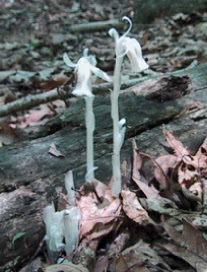 June 18INDIAN PIPES - These ghostly specimens, Indian Pipes, are growing in the East Woods. Like a fungus, they are translucently white and fleshy, are not dependent on sunlight, and grow near decaying vegetable matter. Yet they are wildflowers rather than fungi. Their flowers have pollen and will form seeds. However, because the plants have no chlorophyll, the hard ball-like root mass gets its nutrients from a fungus which in turn is being nourished by this decaying log. The bowl of each "pipe" will tip upward when the flower fruits, so that the plant resembles an oboemore than a peace pipe. Later the fleshy white stalk will become a thin, tough black stem and the upturned bowl will contain the seeds.
June 18INDIAN PIPES - These ghostly specimens, Indian Pipes, are growing in the East Woods. Like a fungus, they are translucently white and fleshy, are not dependent on sunlight, and grow near decaying vegetable matter. Yet they are wildflowers rather than fungi. Their flowers have pollen and will form seeds. However, because the plants have no chlorophyll, the hard ball-like root mass gets its nutrients from a fungus which in turn is being nourished by this decaying log. The bowl of each "pipe" will tip upward when the flower fruits, so that the plant resembles an oboemore than a peace pipe. Later the fleshy white stalk will become a thin, tough black stem and the upturned bowl will contain the seeds.
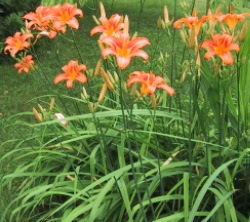 June 15DAYLILIES - Try garnishing a summer salad with a few of these orange beauties. Daylilies have been grown as food in China for thousands of years. The tubers, flowers, and buds are all edible raw or cooked. They have a delicate flavor with just a hint of garlic. The daylily, like the daisy, was brought to Europe centuries ago by early traders, and from there to America.
June 15DAYLILIES - Try garnishing a summer salad with a few of these orange beauties. Daylilies have been grown as food in China for thousands of years. The tubers, flowers, and buds are all edible raw or cooked. They have a delicate flavor with just a hint of garlic. The daylily, like the daisy, was brought to Europe centuries ago by early traders, and from there to America.
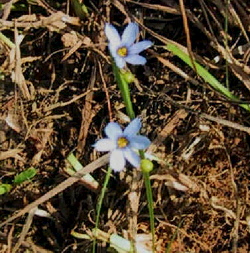 June 4BLUE-EYED GRASS - You may find this tiny jewel in your yard. The common name of this wildflower is "Blue-eyed Grass". Its narrow, flattened stem and its leaves resemble blades of grass but it is actually a member of the Iris family and native to Maryland. The flower itself, only about one-half inch across, has delicate points on the tip of each petal and a pretty yellow eye. You'll find it in a fairly sunny spot in moist soil.
June 4BLUE-EYED GRASS - You may find this tiny jewel in your yard. The common name of this wildflower is "Blue-eyed Grass". Its narrow, flattened stem and its leaves resemble blades of grass but it is actually a member of the Iris family and native to Maryland. The flower itself, only about one-half inch across, has delicate points on the tip of each petal and a pretty yellow eye. You'll find it in a fairly sunny spot in moist soil.
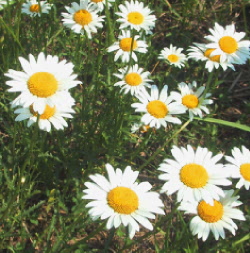 June 4CHRYSNATHEMUMS - It wouldn't be June without daisies! Chrysnathemums were originally cultivated and hybridized by the Chinese over 2,000 years ago. Early traders brought the flower to Europe where it quickly naturalized. The Oxe-eye daisy, and Feverfew, another chrysanthemum, travelled across the Atlantic, perhaps unnoticed, with the early American colonists. The name "daisy"(day's eye, or eye of the day, as Chaucer explained in verse) originally referred to a different flower.
June 4CHRYSNATHEMUMS - It wouldn't be June without daisies! Chrysnathemums were originally cultivated and hybridized by the Chinese over 2,000 years ago. Early traders brought the flower to Europe where it quickly naturalized. The Oxe-eye daisy, and Feverfew, another chrysanthemum, travelled across the Atlantic, perhaps unnoticed, with the early American colonists. The name "daisy"(day's eye, or eye of the day, as Chaucer explained in verse) originally referred to a different flower.
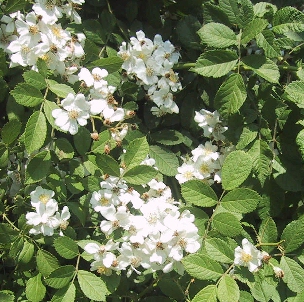 May 28MULTIFLORA ROSE is considered an undesirable exotic invader butit certainly is beautiful when it is in bloom! This specimen is in the Casey field but you can find thickets of it throughout the Grove.
May 28MULTIFLORA ROSE is considered an undesirable exotic invader butit certainly is beautiful when it is in bloom! This specimen is in the Casey field but you can find thickets of it throughout the Grove.
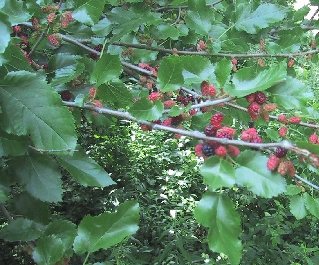 May 28MULBERRIES - The mulberries are beginning to ripen now and will create a mess beneath the branches for a while!! The fruit of this common wild tree is a favorite with many birds including Mockingbirds, Orioles, Robins, Woodpeckers, Bluebirds and even with box turtles. Although they are definitely second-rate people-food, some children enjoy them!
May 28MULBERRIES - The mulberries are beginning to ripen now and will create a mess beneath the branches for a while!! The fruit of this common wild tree is a favorite with many birds including Mockingbirds, Orioles, Robins, Woodpeckers, Bluebirds and even with box turtles. Although they are definitely second-rate people-food, some children enjoy them!
 May 26SASSAFRAS is a common "weed tree" around the Grove, but it is a native tree and a member of the laurel family. This young specimen is growing between the parking lot in Woodward Park and the baseball backstop. Look for the mitten shaped leaves, sometimes with two thumbs! Tear a leaf and smell it. They are deliciously aromatic. Sassafras tea, which you may have heard your grandparents speak of, is brewed by boiling the bark of the young roots. The same aromatic oil has been used to scent or flavor candies, gum, soaps, and medicines, but is best recognized as a flavor ingagent in the beverage "sarsaparilla" and root beer. Don't try serving these distinctly American favorites to a European. You have to have native "roots" to appreciate the taste!
May 26SASSAFRAS is a common "weed tree" around the Grove, but it is a native tree and a member of the laurel family. This young specimen is growing between the parking lot in Woodward Park and the baseball backstop. Look for the mitten shaped leaves, sometimes with two thumbs! Tear a leaf and smell it. They are deliciously aromatic. Sassafras tea, which you may have heard your grandparents speak of, is brewed by boiling the bark of the young roots. The same aromatic oil has been used to scent or flavor candies, gum, soaps, and medicines, but is best recognized as a flavor ingagent in the beverage "sarsaparilla" and root beer. Don't try serving these distinctly American favorites to a European. You have to have native "roots" to appreciate the taste!
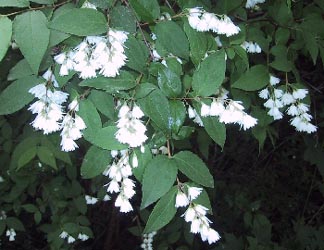 May 26DEUTSIA - This lovely shrub is in full bloom now. You can find specimens along Chestnut Road and there is another variety with more open blossoms on the corner of Oak and Maple Road. Ann Briggs finally identified it as "Deutsia," a landscaping shrub more familiar to past generations. Very easily propagated from cuttings, it is a relative of the mock orange, hydrangea, and current. Deutsia (pronouced "doot - zee - a") is named for Johan vander Deutz, 1743-1784, mayor of Amsterdam and a patron of botany. Perhaps its most interesting feature to Grove residents is that it doesn't interest deer!
May 26DEUTSIA - This lovely shrub is in full bloom now. You can find specimens along Chestnut Road and there is another variety with more open blossoms on the corner of Oak and Maple Road. Ann Briggs finally identified it as "Deutsia," a landscaping shrub more familiar to past generations. Very easily propagated from cuttings, it is a relative of the mock orange, hydrangea, and current. Deutsia (pronouced "doot - zee - a") is named for Johan vander Deutz, 1743-1784, mayor of Amsterdam and a patron of botany. Perhaps its most interesting feature to Grove residents is that it doesn't interest deer!
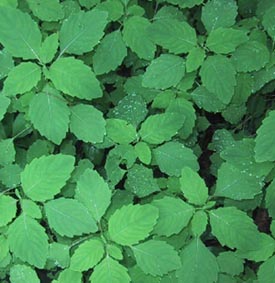 May 26JEWELWEED - The Jewelweed near the town garage is about 18 inches high now. After a rain, as in this picture, water beads up on jewelweed leaves in a distinctive way. Look for jewelweed next to streams, the lake, or any place that is often wet. The March 29 entry in this column has more information about this useful herb.
May 26JEWELWEED - The Jewelweed near the town garage is about 18 inches high now. After a rain, as in this picture, water beads up on jewelweed leaves in a distinctive way. Look for jewelweed next to streams, the lake, or any place that is often wet. The March 29 entry in this column has more information about this useful herb.
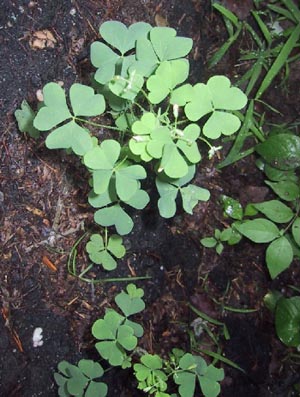 May 26YELLOW WOODSORREL - This little herb is probably familiar to anyonewho has weeded a garden. It's real name is Oxalis, but it is best known as "Yellow Woodsorrel" because of its flavor. Next time you pull some, wash it and taste it. The flower, leaves and stem are edible and have a sour-sweet flavor. It is lovely mixed into a salad, but the oxalic acid, as in true sorrel, rhubarb and spinach, can be mildly toxic in large quantities.
May 26YELLOW WOODSORREL - This little herb is probably familiar to anyonewho has weeded a garden. It's real name is Oxalis, but it is best known as "Yellow Woodsorrel" because of its flavor. Next time you pull some, wash it and taste it. The flower, leaves and stem are edible and have a sour-sweet flavor. It is lovely mixed into a salad, but the oxalic acid, as in true sorrel, rhubarb and spinach, can be mildly toxic in large quantities.
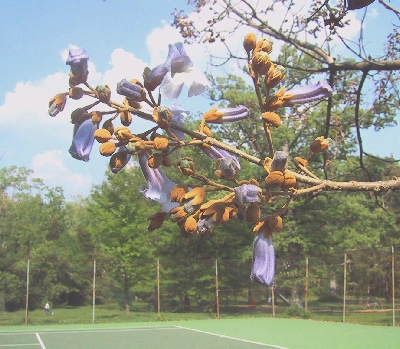 May 2PAULOWNIA - These showy purple flowers have bloomed on the trees between the tennis courts. Do you know what this very interesting tree is?
May 2PAULOWNIA - These showy purple flowers have bloomed on the trees between the tennis courts. Do you know what this very interesting tree is?
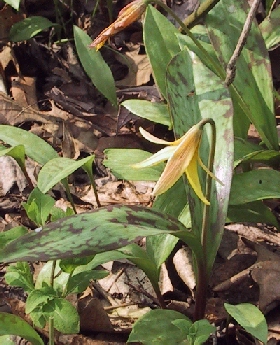 April 27TROUT LILY - The Trout Lily (in the east woods near the pool that Jim Fletcher created by damming the creek) is nearing the end of its bloom now. It doesn't last long!
April 27TROUT LILY - The Trout Lily (in the east woods near the pool that Jim Fletcher created by damming the creek) is nearing the end of its bloom now. It doesn't last long!
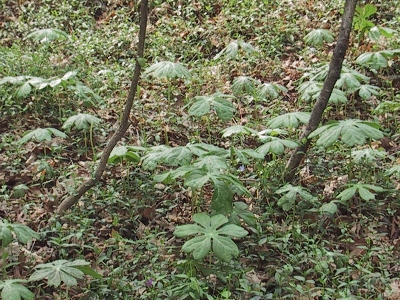 April 27MAYAPPLE grows in large colonies throughout the woods. Right now, if you look beneath the leaves of the older mayapple plants, those with two leaves, you can find a single bud in the fork of the stem. This will become a white flower, and will later be followed by a small, lemon-shaped fruit.
April 27MAYAPPLE grows in large colonies throughout the woods. Right now, if you look beneath the leaves of the older mayapple plants, those with two leaves, you can find a single bud in the fork of the stem. This will become a white flower, and will later be followed by a small, lemon-shaped fruit.
Wonderful article about mayapple by Paul Andrews of DaylilyLane.
 April 27CORM - Spring Beauty is carpeting large grassy areas in the parks right now. Jim Fletcher often delays mowing the prettiest patches during the peak of bloom. After a few weeks the drifts will have disappeared although you can find individual specimens throughout the summer. The delicate white or pink flowers have tiny pink stripes on the petals and only open in sunlight. The corm can be eaten raw or boiled, but is small and not worth destroying the wildflower for.
April 27CORM - Spring Beauty is carpeting large grassy areas in the parks right now. Jim Fletcher often delays mowing the prettiest patches during the peak of bloom. After a few weeks the drifts will have disappeared although you can find individual specimens throughout the summer. The delicate white or pink flowers have tiny pink stripes on the petals and only open in sunlight. The corm can be eaten raw or boiled, but is small and not worth destroying the wildflower for.
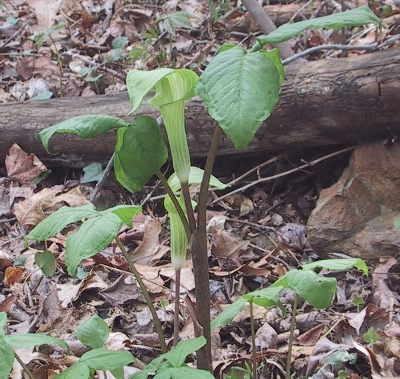 April 27JACK-IN-THE-PULPIT - Look for the jack-in-the-pulpit plants scattered here and there throughout the woods. In some, the curled leaf-like "pulpit" or spathe has dark purplish stripes inside. The plant is also called "Indian turnip" because natives used to boil or bake the root, peel it, dry it and pound it into a flour that could then be baked into nutritious little cakes. This process renders the dangerously acrid root almost tasteless.
April 27JACK-IN-THE-PULPIT - Look for the jack-in-the-pulpit plants scattered here and there throughout the woods. In some, the curled leaf-like "pulpit" or spathe has dark purplish stripes inside. The plant is also called "Indian turnip" because natives used to boil or bake the root, peel it, dry it and pound it into a flour that could then be baked into nutritious little cakes. This process renders the dangerously acrid root almost tasteless.
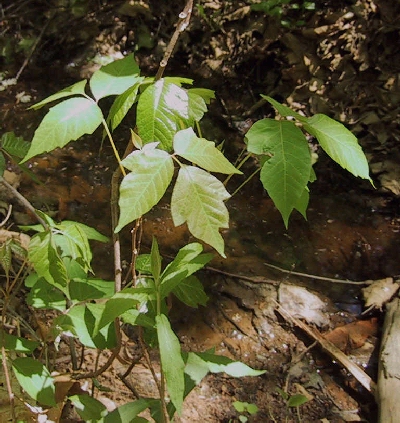 April 27POISON IVY - Beware of poison ivy! Right now most specimens are just beginning to leaf out and are still small, shiny and coppery-colored. It grows EVERYWHERE in the Grove. If you aren't good at recognizing it, find a specimen now and keep an eye on it as it changes during the summer and fall. Ann Briggs points out that poison ivy is not all bad. Some of our wintering birds such as Eastern Bluebirds, Cedar Wax wings, and Hermit Thrushes thrive on its berries! She also becomes very poetic in describing the beauty of the whitish waxy flowers.
April 27POISON IVY - Beware of poison ivy! Right now most specimens are just beginning to leaf out and are still small, shiny and coppery-colored. It grows EVERYWHERE in the Grove. If you aren't good at recognizing it, find a specimen now and keep an eye on it as it changes during the summer and fall. Ann Briggs points out that poison ivy is not all bad. Some of our wintering birds such as Eastern Bluebirds, Cedar Wax wings, and Hermit Thrushes thrive on its berries! She also becomes very poetic in describing the beauty of the whitish waxy flowers.
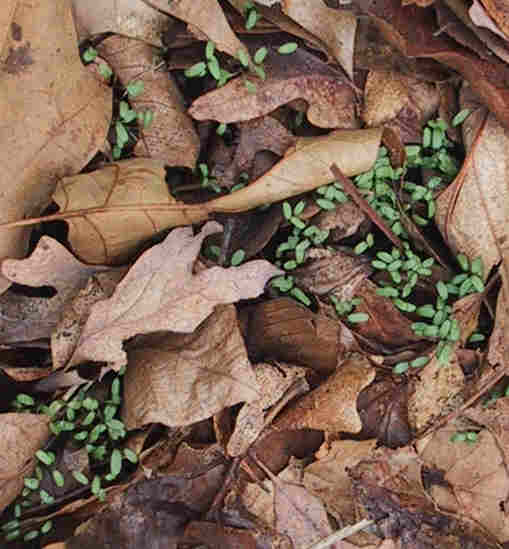 March 29, 2001JEWELWEED - Look along Center Street near the town garage or along the length of the walkway that enters the woods there and you can see patches of energetic seedlings pushing up through last year's oak leaves. They are the sprouts of jewelweed, a wild impatiens plant with orange flowers and succulent stems. Many town children look for jewelweed when they have been stung. Applying the crushed leaves or stems to the skin helps relieve itching or pain. By July, these plants will be three feet high!
March 29, 2001JEWELWEED - Look along Center Street near the town garage or along the length of the walkway that enters the woods there and you can see patches of energetic seedlings pushing up through last year's oak leaves. They are the sprouts of jewelweed, a wild impatiens plant with orange flowers and succulent stems. Many town children look for jewelweed when they have been stung. Applying the crushed leaves or stems to the skin helps relieve itching or pain. By July, these plants will be three feet high!
 March 29TROUT LILY leaves are beginning to appear in the woods but you may have to lift a few oak leaves to find them. This patch is on the left just before you reach the end of Cherry Ave walkway in the woods. You may know this wet-woodlands wildflower as "yellow adder's tongue", "dog-tooth violet" or "fawn lily." Troutlilies.
March 29TROUT LILY leaves are beginning to appear in the woods but you may have to lift a few oak leaves to find them. This patch is on the left just before you reach the end of Cherry Ave walkway in the woods. You may know this wet-woodlands wildflower as "yellow adder's tongue", "dog-tooth violet" or "fawn lily." Troutlilies.
 March 13SKUNK CABBAGE is blooming in the West Woods. Walk along the main path into the woods to the stream. walk upstream quite a distance and you can find skunk cabbage growing in and along the creek Deer must have disturbed (stepped on?) some of the skunk cabbage here because the odor has wafted past the Andrew's house recently! There is also some skunk cabbage growing near the spring that feeds Maple Lake.
March 13SKUNK CABBAGE is blooming in the West Woods. Walk along the main path into the woods to the stream. walk upstream quite a distance and you can find skunk cabbage growing in and along the creek Deer must have disturbed (stepped on?) some of the skunk cabbage here because the odor has wafted past the Andrew's house recently! There is also some skunk cabbage growing near the spring that feeds Maple Lake.
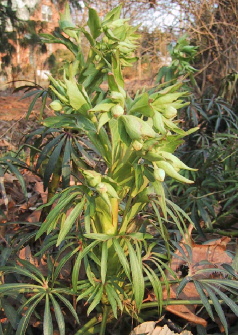 March 13HELLEBORUS ARGUTIFOLIUS are in full bloom at the corner of Oak Street and Chestnut Road. You will see clusters of cup-shaped, nodding, green flowers on upright spikes. Look around for a few red-bloomed plants.
March 13HELLEBORUS ARGUTIFOLIUS are in full bloom at the corner of Oak Street and Chestnut Road. You will see clusters of cup-shaped, nodding, green flowers on upright spikes. Look around for a few red-bloomed plants.